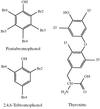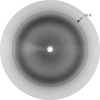issue contents
September 2000 issue

Cover illustration: Molecular-surface renderings of the N-terminal fragment of MMLV RT with the intervening DNA shown as stick models (p. 1120).
research papers
The X-ray structure of human transthyretin, a thyroid hormone transport protein, has been studied in complexes with two organohalogen substances, pentabromophenol and 2,4,6-tetrabromophenol, which bind the protein in competition with the natural ligand thyroxine.
The crystal structure of jack bean chitinase is presented and its active-site architecture is discussed.
PDB reference: jack bean chitinase, 1dxj
Seven crystal structures of feline immunodeficiency virus dUTPase in three crystal forms have been determined, including the complexes with dUTP, dUDP and dUMP. The studies reveal that the enzyme utilizes an adaptive recognition to bind the substrate in order to catalyze the reaction.
X-ray analyses and a comparative study of a large number of crystal structures of lysozyme show that the changes in the molecular geometry and hydration of the enzyme caused by variation in the amount of surrounding water are more pronounced than those caused by change in pH. They also lead to information on the flexibility and accessibility of the molecule and the role of invariant water molecules including those at the catalytic site.
Complexation with the N-terminal fragment of Moloney murine leukemia virus reverse transcriptase offers a novel method of obtaining crystal structures of nucleic acid duplexes, which can be phased by molecular replacement. Here, a novel DNA structure including two G–A mispairs in a pseudo-hexadecamer determined at 2.3 Å resolution in a complex with the N-terminal fragment is reported.
The previously known 13 kDa protein, pseudoazurin, has been solved by MULTAN88 using 1.55 Å resolution data. Refinement by the density-modification procedure PERP gave a final map that could be interpreted.
An ab initio method is described for solving protein structures for which atomic resolution data are available. The method is illustrated by the solution of a number of known proteins, with up to 5000 atoms.
Probabilistic direct-methods phasing theory is shown to be adaptable to a non-uniform bulk-solvent-compensated approximation for protein crystals at low resolution.
A graphical representation of amino-acid preferences in different backbone packing densities of protein structural classes is presented. Turns/loops in high backbone-density regions are identified using this representation and are found to be located in the dimer interface close to the active/binding site of the protein.
crystallization papers
A D-hydantoinase from Thermus sp. was recombinantly expressed, purified and crystallized as the native and selenomethionine-labelled protein. The crystals belong to the orthorhombic space group C2221 and diffract to 1.7 and 2.5 Å, respectively. 54 Se-Met sites were determined.
The selenomethionine-derivatized dI component of nicotinamide nucleotide transhydrogenase from R. rubrum has been crystallized in a form suitable for X-ray structure determination.
Thermophilic cytochrome P450 (CYP119) from S. solfataricus was crystallized and diffracted to 1.84 Å resolution. It belongs to the tetragonal space group P43212, with unit-cell parameters a = b = 86.71, c = 221.11 Å.
A member of the β-carbonic anhydrase class of zinc metalloenzymes from E. coli has been crystallized in both native and selenomethionine-labelled forms. Multiwavelength anomalous dispersion data sets were collected and used to determine the positions of the zinc cations and selenium sites.
Biliverdin reductase catalyzes the final step of haem degradation and converts biliverdin to bilirubin. X-ray quality crystals have been obtained of recombinant rat biliverdin reductase.
The preliminary crystallographic studies of bar-headed goose fluoromethaemoglobin complexed with its allosteric effector inositol hexaphosphate (IHP) are reported. The IHP molecule density has been observed.
Crystals of intein homing endonuclease II from P. kodakaraensis have been grown at room temperature using ammonium sulfate as a precipitant. The crystals belong to space group C2221, with unit-cell parameters a = 107.6, b = 150.5, c = 146.8 Å.
The head-tail connector of bacteriophage φ29, an oligomer of gene product 10, was crystallized into various forms, including an orthorhombic P22121 form and two monoclinic C2 forms. Rotation functions show the connector to be a dodecamer and translation functions readily determined the position of the 12-fold axis in each unit cell.
An active sulfur analogue of rat cytosolic thioredoxin reductase (SeCys498Cys TrxR) has been highly purified from E. coli and crystallized. X-ray diffraction patterns show that the monoclinic crystals have unit-cell parameters a = 78.9, b = 140.5, c = 170.8 Å, α = 94.6°.
Crystals of a native form and a selenomethionine-substituted form of the E. coli peptide methionine sulfoxide reductase were used to collect a native X-ray diffraction data set at 1.9 Å resolution and to perform two MAD experiments with three wavelengths at 3 Å resolution. From calculated MAD phases, an electron-density map of excellent quality was obtained.
short communications
A water channel, AQP1, from bovine red blood cell membranes has been deglycosylated, purified and crystallized. The crystallization method and preliminary X-ray diffraction data are reported.
The presence of a metal cation–π (Na+–Trp) interaction in a structure of triosephosphate isomerase is presented and discussed.
PDB reference: Triosephosphate isomerase mutant, 2btm


 journal menu
journal menu





































